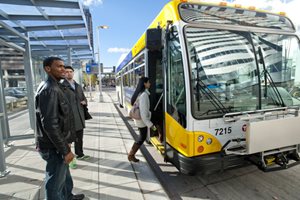A strong system of public transit is an essential part of a prosperous, livable, sustainable, and equitable region. Transitway investments are being made in corridors where there is likely to be significant ridership, as well as the potential for future concentrations of growth. Other types of transit services complement that investment, including local bus service. To ensure a cost-effective regional transit system, it is a policy of the 2040 Transportation Policy Plan (2040 TPP) that communities guide growth at higher densities near stations for light rail, bus rapid transit, commuter rail, and high-frequency bus corridors.

Minimum Requirements:

The region has established Transit Market Areas to guide the types and levels of transit service that are appropriate for efficient and effective services. Transit Market Areas are defined in Appendix G of the 2040 TPP by the demographic and urban design factors that are associated with successful transit service. Identify your community in relationship to your transit market area(s). Describe and map the existing and planned transit infrastructure and services in your community, including those of Metro Transit or other regional transit service providers. Communities should include the identification of the following basic elements of the transit system in their comprehensive plan.
-
Existing transit routes and dial-a-ride services
-
Existing and potential high-frequency transit routes
-
Existing and planned transit stations and transit centers
-
Existing and planned park-and-rides and express bus corridors
-
Existing and planned transit advantages
-
Existing transit support facilities

For communities with transitways in the 2040 TPP Current Revenue Scenario with an identified mode and alignment and for high-frequency bus corridors:
-
Identify the geography of transit station areas.
-
Ensure that land guided for future residential development in station areas conforms to minimum density levels in the 2040 TPP; and address opportunities for residential density at target density levels.
-
Plan for a total level of activity in station areas that is supportive of transitway investments; and address the activity level guideline of a minimum combined total of 7,000 residents, jobs, or students.

For communities with transitways in the 2040 TPP Current Revenue Scenario prior to an identified mode and alignment:
-
Describe the community’s roles and responsibilities in early transitway development, including analysis of potential modes, alignment, and station locations.
-
Describe and map these transitways in your community including alternative alignment(s) and station locations under consideration.

Get More Out of Your Plan:
For communities with transitways identified in the 2040 TPP Current Revenue Scenario prior to identification of mode and alignment:
-
Set vision for potential/future transit stations and corridors with goals for land use patterns and street networks that can support transit-supportive densities and nodes of activity.
-
Work with agencies leading transit planning to evaluate the land use, accessibility, and other advantages and disadvantages of alternative transitway alignments and modes and to identify important locally derived opportunities for transit.
For communities with transitways identified in the 2040 TPP Increased Revenue Scenario:
-
As an option, include these transitways in your comprehensive plan. However, identify them as unfunded and distinguished from improvements identified in system statements.
-
Set vision for potential/future transit corridors with goals for land use patterns and street networks that can support transit-supportive densities and nodes of activity.
-
Work with agencies leading transit planning to evaluate the land use and accessibility advantages and disadvantages of alternative transitway alignments and to identify important opportunities for existing and planned transit.
Other considerations:
-
Identify transit expansion opportunities and target higher-intensity uses and pedestrian-supportive urban forms in nodes along these corridors. Use the 2040 TPP’s “Transit Planning Basics” discussion and TOD Guide for additional guidance.
-
Address the opportunities and challenges for transit related to your Transit Market Area and your Community Designation. Explore how new development and infrastructure policies might improve the cost-effectiveness and attractiveness of transit, ridesharing, bicycling, and walking.
-
Describe transit service to major job, activity, and industrial and manufacturing concentrations in your community.
-
Include ridership data on maps for transit stops in your community.
-
Identify areas for travel demand management initiatives and strategies. Focus on major job, activity, and industrial and manufacturing concentrations on congested highway corridors and corridors served by regional transit service.
-
Develop strategies to create and preserve a mix of housing affordability in areas where land values are likely to escalate after a transitway commitment is made.
-
Identify needed local transportation improvements to support transit use and the land use vision in your comprehensive plan.
-
Explore how transit and ridesharing programs contribute to regional equity goals by better connecting all residents to a wider range of employment, training, and educational opportunities.
-
Incorporate transportation goals, objectives, and strategies outlined in Chapter 2 of the 2040 TPP.
-
Identify transit expansion opportunities and target higher-intensity uses and pedestrian-supportive urban forms in nodes along these corridors. Use the 2040 TPP’s “Transit Planning Basics” discussion and TOD Guide for additional guidance. (Minnesota Healthy Planning: How-To Guide, page 53). For more information, please visit the Minnesota Department of Health Healthy Places website.

We Can Help!
-
See more details in Chapter 1, Chapter 3, Land Use and Local Planning, and Chapter 6, Transit Investment Direction and Plan, of the 2040 TPP.
-
Download GIS data for transitway lines, transit routes, park-and-rides, service frequency, transit use by stop (boardings and alightings), and other transit-related datasets.
-
Review the How-To Guide on guidelines for mapping of transit facilities and services.
-
Consult the How-To Guide on Transit Station Areas, which provides guidance on mapping transit station areas, conforming with residential density requirements, and addressing activity level policy.